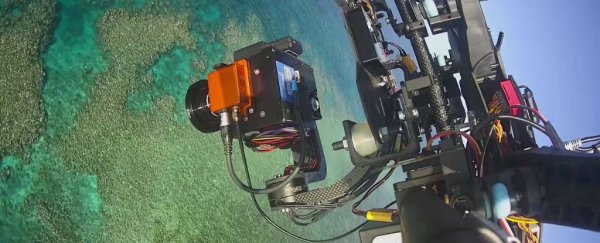We've all heard the terrible stories about the Great Barrier Reef, and the extensive bleaching that has occurred in recent years.
But despite what some news outlets might think, the reef is not actually dead, and we still need to monitor what's happening closely to try to stop the damage where possible.
That's why a team from the Queensland University of Technology (QUT) and the Australian Institute for Marine Science (AIMS) are working on developing a range of technologies to map, monitor, and keep an eye on the health of the Great Barrier Reef.
QUT has done a lot of work in the past into unmanned aerial systems (aka drones) that can be taught by machine learning to monitor the reef quickly and effectively.
"By taking readings from the air and verifying them against the AIMS data from below the surface, we are teaching the system how to see and classify bleaching levels," said one of the researchers from QUT, Felipe Gonzalez.
"Flying 60 metres (200 feet) above the water gives us a spatial resolution of 9.2 centimetres per pixel, which we've found to be more than enough detail to detect and monitor individual corals and their level of bleaching."
The reef is around the size of Japan, with over 3,000 individual reefs stretching across 2,300 kilometres (1,500 miles), so identifying bleached or damaged areas can be quite an intensive task.
"Low-altitude drones can cover far more area in a day than in-water surveys and they're not hampered by cloud cover as manned aircraft and satellites are – a system like this has the real potential to boost the frequency of monitoring activities in an economical way," Gonzalez said.
"The more data scientists have at their fingertips during a bleaching event, the better they can address it. We see small drones with hyperspectral cameras acting as a rapid response tool for threatened reefs during and after coral bleaching events."
But the most impressive bit of this technology is the artificial intelligence behind it. Because the drones produce so much data, an AI has been created to sift through the information and track changes to the reefs.
"We're building an artificial intelligence system that processes the data by identifying and categorising the different 'hyperspectral fingerprints' for objects within the footage," said Gonzalez.
"Every object gives off a unique hyperspectral signature, like a fingerprint… An individual coral colony will give off different hyperspectral signatures as its bleaching level changes, so we can potentially track those changes in individual corals over time. "
The team have released a video, which you can see below, to show how this new technology works.
The team is hoping that this new technology will be a fast, cheap tool for monitoring the reef, hopefully well into the future.
Queensland University of Technology is a sponsor of ScienceAlert. Find out more about their research.
